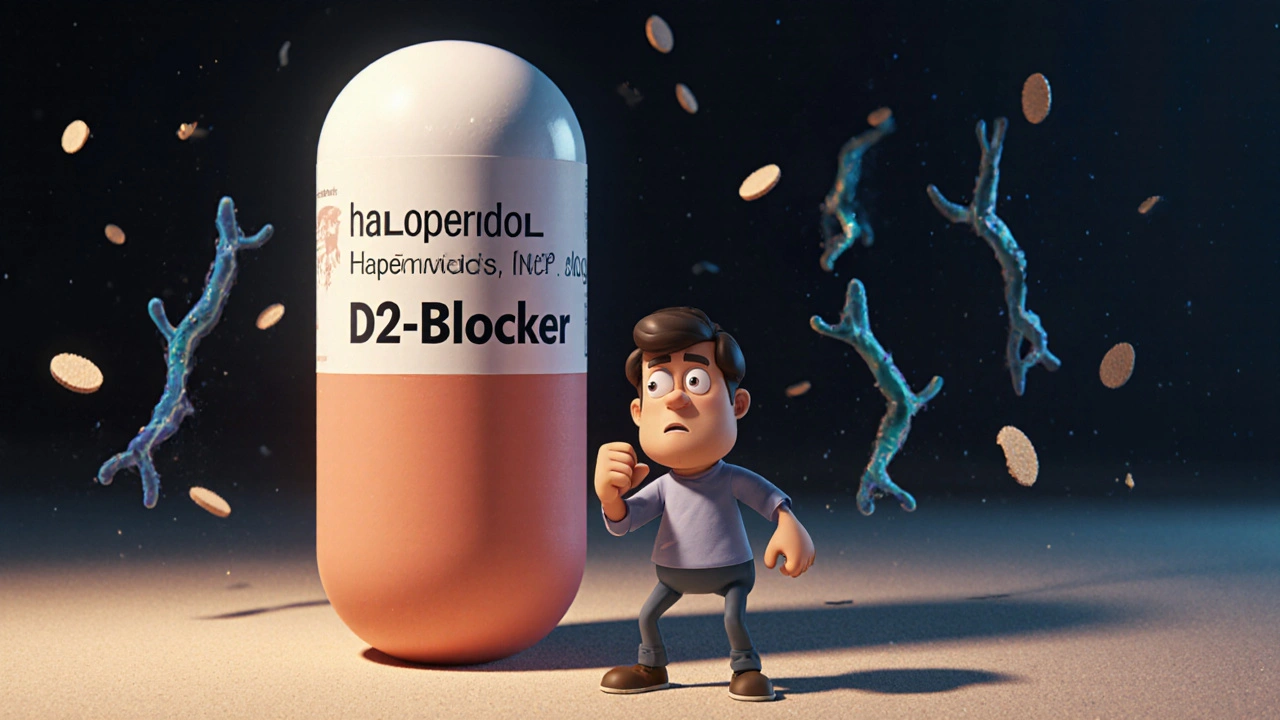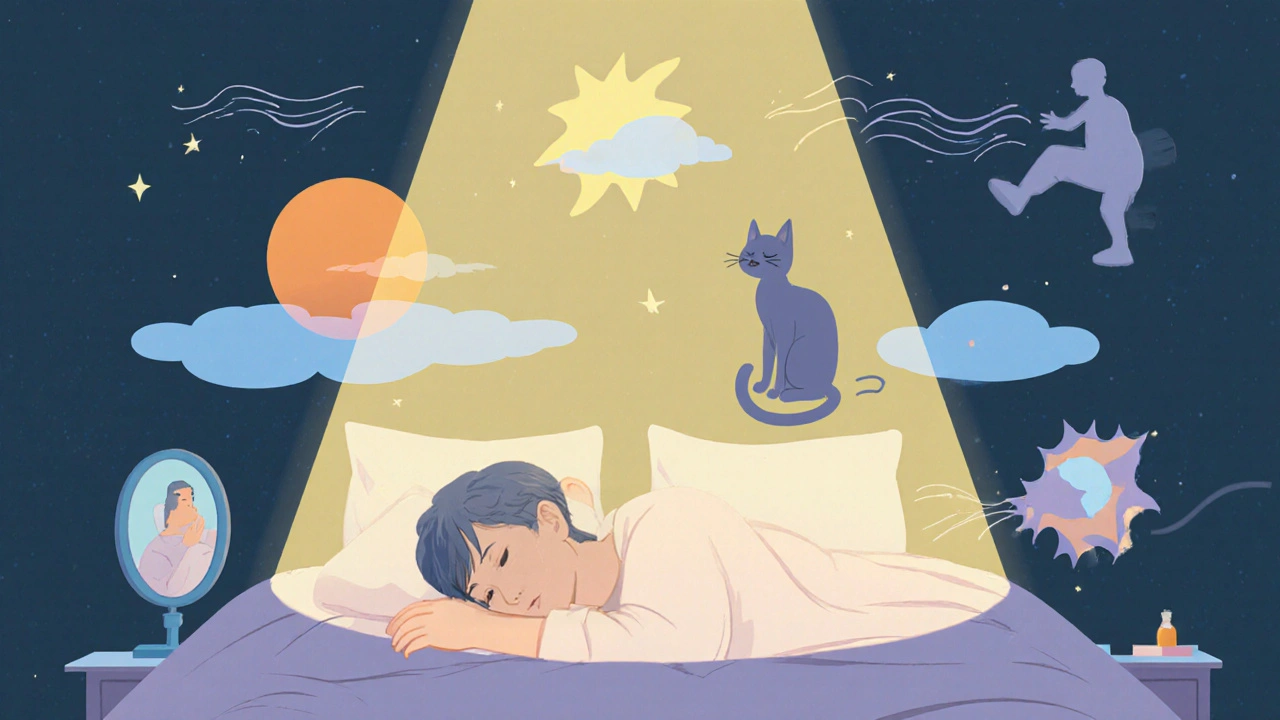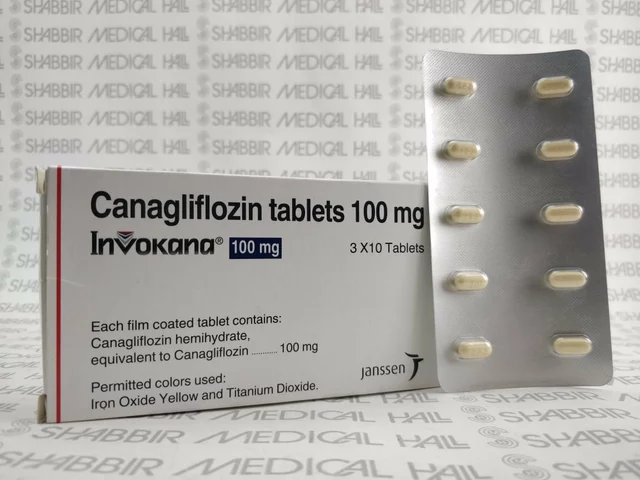Parkinson’s Disease and Antipsychotics: How Certain Medications Worsen Motor Symptoms

Antipsychotic Safety Calculator for Parkinson's
Select Your Priority
Choose what's most important for your treatment decision:
Antipsychotic Comparison
Clozapine
Gold standard for Parkinson's psychosis
FDA-approved specifically for Parkinson's psychosis
Quetiapine
Most commonly used option
Low risk of motor worsening (12.5-25 mg doses)
Risperidone
High risk for Parkinson's patients
Avoid at standard doses (0.5-1 mg/day)
Haloperidol
Most dangerous for Parkinson's
Parkinson's Foundation recommends avoiding
Pimavanserin
FDA-approved but with warnings
Black box warning for increased death risk
Important Considerations
Always try adjusting Parkinson's medications first before considering antipsychotics. 62% of Parkinson's patients with psychosis see improvement after optimizing Parkinson's drugs (reducing anticholinergics, MAO-B inhibitors, etc.).
Clozapine requires weekly blood tests for agranulocytosis monitoring (stop if neutrophil count < 1,500 cells/μL).
Why Antipsychotics Can Make Parkinson’s Worse
People with Parkinson’s disease often develop hallucinations or delusions-symptoms known as Parkinson’s disease psychosis (PDP). It’s a common and distressing part of the disease, affecting nearly one in four patients. But when doctors reach for antipsychotic drugs to calm these symptoms, they risk making the motor problems even worse. That’s because the very mechanism that helps reduce psychosis also blocks dopamine, the same brain chemical that’s already dangerously low in Parkinson’s.
Think of it like this: Parkinson’s is caused by the loss of dopamine-producing neurons in a part of the brain that controls movement. That’s why patients struggle with slow movements, stiffness, tremors, and balance issues. Antipsychotics, especially older ones, work by shutting down dopamine receptors-specifically the D2 type-to reduce psychotic thoughts. But in someone with Parkinson’s, there’s already not enough dopamine to begin with. Blocking what’s left can push the motor system into freefall.
The Worst Offenders: First-Generation Antipsychotics
Not all antipsychotics are created equal when it comes to Parkinson’s. First-generation drugs-also called typical antipsychotics-are the biggest danger. These include haloperidol (Haldol), fluphenazine, and chlorpromazine. They bind tightly to D2 receptors, often occupying 90% or more of them at standard doses. That’s why they’re so effective for schizophrenia but so dangerous for Parkinson’s patients.
Studies show that haloperidol causes parkinsonism in 70 to 80% of Parkinson’s patients, even at tiny doses like 0.25 mg per day. In one 2020 textbook, it was described as "particularly dangerous"-so much so that the Parkinson’s Foundation recommends avoiding it entirely. Many patients on these drugs end up with sudden, severe rigidity, freezing episodes, or even the inability to walk. Some are hospitalized because their motor function collapses.
Second-Generation Antipsychotics: A Mixed Bag
Second-generation antipsychotics (SGAs) were once thought to be safer because they have lower D2 receptor affinity and also act on serotonin receptors. But the reality is more complicated. Risperidone, for example, may help with hallucinations-but at a steep cost. A 2005 double-blind trial found that while risperidone reduced psychosis as well as clozapine, it caused motor symptoms to worsen by an average of 7.2 points on the UPDRS-III scale. That’s a major decline. Worse, a 2013 Canadian study found risperidone nearly doubled the risk of death in Parkinson’s patients.
Olanzapine had similar problems. In one study of 12 patients, 75% saw their motor symptoms get worse, and only one person could stay on the drug. Even low doses of risperidone (0.5 mg) showed no motor worsening in a small 2001 study-but that’s not enough to override the larger, more reliable data. The pattern is clear: most SGAs still carry too much risk.

The Two Safer Options: Clozapine and Quetiapine
There are two antipsychotics that have earned a place in Parkinson’s treatment-not because they’re perfect, but because they’re the least bad.
Clozapine is the gold standard. It has very low D2 receptor occupancy (around 40-60%) and a unique chemical profile that avoids triggering motor side effects. In multiple high-quality studies, it reduces psychosis without worsening movement. The FDA approved it specifically for Parkinson’s psychosis in 2016. But it’s not simple to use. Clozapine carries a rare but serious risk of agranulocytosis-a drop in white blood cells that can be life-threatening. That’s why patients on clozapine need weekly blood tests for the first six months. If the absolute neutrophil count falls below 1,500 cells/μL, the drug must be stopped immediately.
Quetiapine is used off-label and is much easier to start. It doesn’t require blood monitoring and is often tried first because it’s safer to initiate. But here’s the catch: its effectiveness is debated. Some studies show it helps. Others, including a 2017 trial, found no real difference between quetiapine and a placebo in reducing hallucinations. Still, many neurologists use it because it’s low-risk for motor symptoms. Doses are low-usually 12.5 to 25 mg at night-and effects show up in one to two weeks.
What About Pimavanserin and Newer Drugs?
In 2022, the FDA approved pimavanserin (Nuplazid) as the first antipsychotic for Parkinson’s that doesn’t block dopamine at all. Instead, it targets serotonin 5-HT2A receptors. That’s a game-changer-no dopamine blockade means no motor worsening. Clinical trials showed no significant change in UPDRS-III scores. But there’s a dark side: post-marketing data revealed a 1.7-fold increase in death risk. The FDA added a black box warning. Many doctors now avoid it unless other options fail.
One promising drug in the pipeline is lumateperone. Early results from the HARMONY trial (expected in mid-2024) show it reduces psychosis without hurting motor function. If confirmed, it could become a safer alternative to clozapine-without the blood monitoring burden.
Before You Reach for an Antipsychotic: Try This First
Most experts agree: antipsychotics should be the last resort. Before prescribing them, doctors should try adjusting Parkinson’s medications. Sometimes, psychosis isn’t caused by the disease itself-it’s triggered by too much levodopa, dopamine agonists, or anticholinergics.
A 2018 study found that 62% of Parkinson’s patients with psychosis saw their symptoms disappear after simply reducing or switching their Parkinson’s meds. That’s more than half. The recommended order: cut anticholinergics first, then MAO-B inhibitors, then amantadine, then dopamine agonists, then COMT inhibitors, and only lastly adjust levodopa.
If psychosis persists, then-and only then-consider clozapine or quetiapine. And even then, start low. Go slow. Monitor closely.

Monitoring and When to Stop
Once an antipsychotic is started, motor function must be tracked. The Unified Parkinson’s Disease Rating Scale (UPDRS-III) is the gold standard. Neurologists check it every two weeks during the first month. If motor scores rise by more than 30% from baseline, the drug should be stopped immediately.
Also, watch for sudden changes: increased freezing, falling, or inability to speak. These aren’t just side effects-they’re warning signs of a neurological crisis.
And don’t forget: Parkinson’s psychosis often improves with better sleep, brighter lighting, reduced nighttime noise, and caregiver support. Non-drug approaches are often overlooked but can make a real difference.
The Bottom Line
Treating psychosis in Parkinson’s isn’t about picking the strongest antipsychotic. It’s about picking the one that causes the least harm. Haloperidol and risperidone are dangerous. Olanzapine is risky. Pimavanserin has a death warning. Clozapine works but needs blood tests. Quetiapine is easy but may not work at all.
The best approach? Avoid antipsychotics if you can. Optimize Parkinson’s meds first. Use non-drug strategies. And if you must use a drug, choose clozapine with strict monitoring-or quetiapine if clozapine isn’t an option. The goal isn’t just to quiet the hallucinations. It’s to keep the person walking, talking, and living with dignity.
Can antipsychotics cause Parkinson’s disease?
No, antipsychotics don’t cause Parkinson’s disease. But they can cause drug-induced parkinsonism-a condition that looks just like Parkinson’s, with tremors, stiffness, and slow movement. This happens because these drugs block dopamine receptors. The symptoms usually go away after stopping the drug, but in people who already have Parkinson’s, the damage can be permanent or make their existing symptoms much worse.
Is quetiapine safe for Parkinson’s patients?
Quetiapine is considered the safest antipsychotic to start with for Parkinson’s patients because it rarely worsens motor symptoms. But its effectiveness for psychosis is uncertain-some studies show it works, others show it’s no better than a placebo. It’s often used because it’s easy to prescribe and doesn’t require blood tests. Doses are low (12.5-100 mg daily), and effects appear within days to weeks.
Why is clozapine not used more often?
Clozapine is the most effective antipsychotic for Parkinson’s psychosis, but it’s underused because it requires weekly blood tests to monitor for agranulocytosis-a rare but deadly drop in white blood cells. The risk is about 0.8%, and if the neutrophil count falls below 1,500 cells/μL, the drug must be stopped. Many doctors and patients avoid it because of the hassle and fear of complications, even though it’s the only one proven to treat psychosis without making movement worse.
Can you use antipsychotics if you have dementia with Lewy bodies?
People with dementia with Lewy bodies (DLB) are even more sensitive to antipsychotics than those with Parkinson’s. Standard antipsychotics can cause severe reactions, including sudden death. Clozapine and pimavanserin are the only options with any safety data, but even then, extreme caution is needed. Many neurologists avoid antipsychotics entirely in DLB and focus on non-drug strategies like environmental changes and behavioral support.
What are the non-drug ways to manage psychosis in Parkinson’s?
Many cases of Parkinson’s psychosis improve without drugs. Simple changes like increasing daytime light exposure, reducing nighttime noise, improving sleep hygiene, and removing mirrors or clutter that cause misperceptions can help. Caregiver education is critical-knowing how to respond calmly to hallucinations (without arguing) reduces distress. Treating underlying issues like urinary tract infections or sleep apnea can also eliminate psychotic symptoms.
How long does it take for clozapine to work in Parkinson’s patients?
Clozapine takes time. Most patients don’t see improvement for 4 to 6 weeks, and full benefits may take up to 12 weeks. Dosing starts very low-6.25 mg at night-and is increased slowly, usually by 6.25 mg every few days. The goal is 25-50 mg daily. Rushing the dose increases the risk of side effects without speeding up results.
What Comes Next?
If you or a loved one is dealing with Parkinson’s psychosis, talk to a neurologist who specializes in movement disorders-not a general psychiatrist. The right expert knows the risks, the alternatives, and how to balance brain health with mobility. Don’t accept a prescription for haloperidol or risperidone without asking: "Is there a safer option?" The answer might save someone’s ability to walk, speak, and live independently.






Molly Britt
November 1, 2025 AT 00:56They just keep pushing pills like it’s candy. My grandma was on Haldol for a week and couldn’t walk for months. No one even warned us.
Lenard Trevino
November 2, 2025 AT 11:17I’ve been watching this play out in my dad’s care for years. They throw risperidone at every weird look he gives the cat like it’s a magic bullet. But then he freezes in the hallway, can’t turn around, and we’re stuck waiting for the meds to wear off. It’s not treatment-it’s a gamble with his dignity. I’ve seen guys on quetiapine who still laugh at their reflections, but at least they can still hold a coffee cup. Clozapine? Yeah, I’d do the blood draws. Better than watching someone lose their legs to a drug meant for schizophrenics in the ‘70s.
Daniel Taibleson
November 4, 2025 AT 06:20This is one of the most clinically nuanced pieces I’ve read on PDP in years. The emphasis on non-pharmacological interventions-lighting, sleep hygiene, caregiver education-is absolutely critical. Too often, neurologists default to medication because it’s faster, but the data shows that over half of psychosis cases resolve with medication adjustments alone. The real tragedy isn’t the lack of options-it’s the lack of time clinicians have to explore them. We need systemic changes, not just better drugs.
Patricia Roberts
November 4, 2025 AT 17:23Oh wow, so the pharmaceutical industry didn’t invent a drug that doesn’t block dopamine just to make more money? Shocking. Next you’ll tell me the FDA isn’t just a revolving door for Big Pharma execs. Pimavanserin? Sure, it’s ‘FDA-approved’-just like Vioxx was before it killed people. Let’s not pretend this isn’t profit-driven medicine dressed up in white coats.
Paul Maxben
November 5, 2025 AT 07:29they dont want you to know this but clozapine is banned in 3 countries and the blood tests are a scam to make you pay for labs every week. they just want you dependent. my cousin died on it and they said it was 'agranulocytosis' but i think it was poison. dont trust the system.
Julisa Theodore
November 5, 2025 AT 11:45So let me get this straight-we’re giving people with Parkinson’s drugs that turn them into statues… just so they stop seeing ghosts? That’s not medicine. That’s exorcism with a prescription pad. Why not just tell them the ghosts are just their brain’s way of saying, ‘Hey, I’m tired of being ignored.’ Maybe the hallucinations aren’t the problem-maybe the meds are. Just let the old man talk to his dead wife. Who are we to say he’s wrong?
Adrian Clark
November 6, 2025 AT 03:08Quetiapine doesn’t work? Newsflash: neither does hope. I’ve seen three Parkinson’s patients on it. One got better, one stayed the same, one cried because he couldn’t tie his shoes anymore. But at least none of them died from it. Meanwhile, haloperidol? That’s the medical equivalent of slapping a toddler for crying. It shuts them up-then they can’t walk. So yeah, quetiapine might be a placebo. But at least the placebo doesn’t bury you.
Jamie Gassman
November 8, 2025 AT 00:27Let’s be brutally honest: the entire neuropharmacology field is a house of cards built on dopamine dogma. The fact that we still treat psychosis in neurodegenerative disease with dopamine antagonists is not a scientific oversight-it’s institutional arrogance. We’ve known since the 1950s that dopamine isn’t just a ‘movement chemical.’ It’s tied to perception, salience, and identity. Blocking it in a brain already starved of it is like removing the last candle in a burning building and calling it ‘fire prevention.’ The real breakthrough isn’t pimavanserin-it’s admitting we don’t understand the brain, and we’ve been treating symptoms like crimes instead of symptoms like signals. The FDA’s black box warning on pimavanserin? That’s not a safety flag-it’s a confession.
Nick Cd
November 9, 2025 AT 22:02you think this is bad wait till you find out the real reason they dont want you using clozapine its because the government uses the blood test data to track who has parkinsons and then flags them for social security cuts and insurance denial and they even use it to predict when youll die so they can raise your premiums you think thats a coincidence the same people who make the drugs also run the labs and the hospitals and the insurance companies theyre all connected and theyre watching you right now